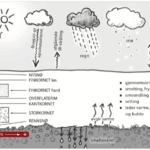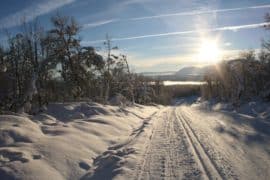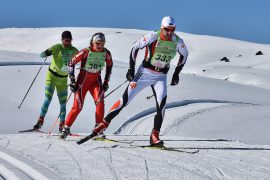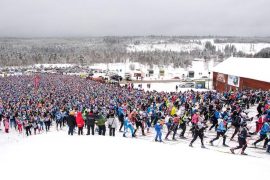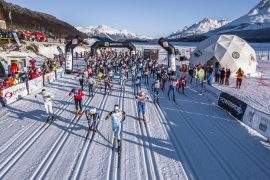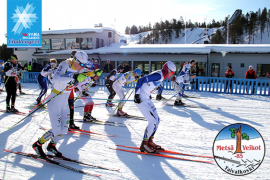This post is also available in:
 Norsk bokmål
Norsk bokmål
In this series xc-marathon.com is thoroughly reviewing the mysteries of ski waxing, grip, glide, structure, ski construction – and all the other elements – that the everyday skier didn´t know that we should have known about. And we get help from the best people there is to find. The world´s largest wax producer Swix is our guide in this jungle, and in this article we also get help from Sportsbua (the Sports shack) in Trondheim.
Let´s start by looking at the ski itself:

We will thoroughly go through all the different elements that affects your glide and grip when skiing. And we get help from the premium expertise: Henrik Johnsen is racing director and have worked in Swix for 7 years. He is responsible for cross-country racing services, within cross country, biathlon and xc-marathon in Norway, as well as sponsor follow-up among Norwegian pro skiers. Harald Bjerke is now retired, but have formerly worked as product manager at Swix from 1972 to 2013. Today he is product manager assistant and ‘ museum director ‘ for the Swix museum.
Part 1 of this series you can read here.
The ski itself consists fo different components that should give a good skiing experience. What hobbyist skiers know about the skis properties varies. Waxing zone, ski tension, profile and structure are different issues that returns to the skiers attention, but what do they mean? What about the length of the ski? Is the tip (front) or the back end of the ski the most important?
To explain how the ski is built, Swix and xc-marathon.com have invited Bengt-Magnus Mathisen from Sportsbua in Trondheim. Sportsbua is probably the leading experts among cross country ski stores in Trondheim. Bengt-Magnus is every year visiting the ski producers and picks skis on behalf of the store and it´s customers, and also have long experience as a waxer for Team Veidekke Midt-Norge (mid-Norway), the Norwegian federations recruit team and Team United Bakeries. He also gives important waxing advice to the demanding and curious customers of Sportsbua before every xc-marathon in the mid-Norway area together with his colleague Andreas Helgemo (which is also the waxer in charge for Team Veidekke Mid-Norway).
Warm or cold conditions most decisive for the construction
Bengt-Magnus explains that the contruction to a great extent is decided by if the ski is being used for warm or cold conditions. -The central issue is the skis contact area, Mathisen explains and continues: -in cold conditions we want to have a sufficient area of contact with the snow to create friction. Then the snow is so cold, that we want a certain heating up through friction and thereby creating friction and thus achieve a thin water film. This film improves the glide ability because kald, dry snow otherwise would have slowed the skis movement over the snow, he explains (more about water film, structure and friction further down in the article, ed. note). -For warm conditions it is the opposite, Bengt-Magnus continues: -then we want a small area of contact because it is so wam that there is a surplus of of water under the ski that creates a ´drag´ (the bigger the area, the more drag, ed. note), and we want to transport the water away (which Swix will adress further down in the article, ed. note).

If you think that you need to grind the skis right before a race because you for example haven´t had time before, use Fibertex to ´round off´ the result a little bit.
Harald Bjerke, Swix.

The ski tip must adjust to the snows hardness or softness
-The tip is probably the second most important part of the ski to focus on, Bengt-Magnus says: -A stiff tip will dig down into soft, (warm) snow, and ´drag´ the ski, but will as we learned above contribute to a greaer contact area for cold skis. With a cold ski you can still say that the specific waxing zone (see ill. above) reaches as long forward on the ski as with a warm ski (seen forward towards the tip from the foot) but the tip “splits” or suspends less and thus gives a longer gliding area. With warm conditions, thus we want a softer tip that follows (suspends) more the softer snow, but as with colder, firmer conditions will vibrate more and thus create both a smaller contact area and a less steady ski, Bengt-Magnus explains.

-When it comes to the core of the ski a lot of producers use different specific names and expressions to describe this, nut one doesn´t need to get too mislead. Descriptions as honeycomb or carbonlite, describes to a greater extent how the producers achieve the properties that we described above, more than unique properties (that you vannot get from other skis) Bengt-Magnus underlines. -But of course, when it comes to the weight of the ski there is a big difference between a wooden core and lighter materials like carbon, etc. The weight of one ski with wooden and carbon core can for example be respectively 757 og 546 grams (Mathisen have ceased the opportunity to weigh two different skis), which means almost half a kilo together, he says. -And the best and most expensive materials is by the way more flexible with regards to choice of tension and softness compared to the skis other properties (as described above).
Tension for one single skier is decided by competence and experience
-And it is also, of course, the skier´s level of skills and weight that decides what tension a ski should have within the main categories ´warm´ or ´cold´ (the tension creates the waxing ´pocket´ that the grip wax is applied to and that should not be in contact with the snow exept from the moment of the kick, se ill. above; ed. note). -And this is where our competence at Sportsbua (or your local store) is extra important Bengt-Magnus points out. We travel to the factories and gets to pick the varieties of tension that we want. This gives out customers the possibility to order skis that fits as good as possible to exactly them, in good time before the season starts. XXXXX -The tension we choose between is practically a little softer or alittle stiffer, depending on the skier´s skills, preferences weight and the purpose of the skis. A little softer tension demands a little less strength, or ´lash´ in the kick to get grip. A little stiffer ski on the contrary, requires more strength but will also give better glide on both cold and warm conditions as we have explained above.
Skating skis
Sidecut is also a property of the ski that is sometimes discussed, but it was happening more before, this is not as important anymore, Bengt-Magnus says, and continues: -But the tension is also important with skating skis. If one were to compare skating skis and classical skis, then as we adressed before we are concerned with the heightof the waxing ´pocket´ for classical skis. This is to be able to apply a thick enough layer of grip wax under differing conditions. With skating skis this height is not important since we are not applying grip wax, but we put more emphasis on the curve or arc (as shown in the figure above) in the whole ski; where it starts and ends, and thus how long the contact area it has towards the snow (in the same way as with classical skis). As for skating skis one often wants a more stiff ski on cold conditions, because usually it is then firmer conditions (…and then the ski cannot ´dig´ itself down in the snow as with warmer conditions, ed. note.) Then the snow gets firmer and then we want a stiffer ski, which also is more directionally stable. Then you get more back from the kick/push. At warmer conditions, on the other hand, a too stiff ski will ´dig´ itself into the snow and drag/decrease the speed, in the same way as a classical ski.

Trampoline effect
-For skating skis the tension is important also to create the trampoline effect one can get. Then you get more power out of the kick/push, and more speed ahead, Bengt-Magnus explains. -That´s why the weight and the strenght of the skier is important also here, he says, and points towards two of the best in this area: -Ole Einar Bjørndalen uses the trampoline effect with a lot of ´lash´; while Thomas Alsgaard looks more like being on a sunday hike; he has less lash, but still a lot of power through the whole kick/push. Thus both exploits the tension of the skating ski.
-The skating skis also have more torsion stiffness, which means to what extent they can be twisted (in opposite direction in the back and front, like a cloth). This is important to keep the power from the kick thrpugh the ski and into the ground, in the speed direction of the ski, Bengt-Magnus contunes to explain.
-On skating skis, the tip is also a little lower and lighter. That´s because the tip doesn´t play as an important role as on the classical skis, in which it after the kick gets an angle that, without the tip, would have the ski ´digging´ itself into the snow.
Double poling skis
-Double poling skis are really a hybrid between skating skis and classical skis, Mathisen continues. -They should, as a skating ski be torsionally stiff to give as much directional stability as possible and thus speed straigh ahead. A double poling ski also have a small reinforcement under the middle of the ski (inside) that makes it more directionally stable, and this is what it has inherited from the skating ski. Aside from that a double poling ski is more of a classical ski than a skating ski: A double poling ski should be easy to double pole with uphill as opposed to a skating ski. And then we a re back to the tension again. When you double pole in an uphill you want as little resistance as possible from the tension, you should not have to work to push the ski down. The profile of a double poling ski otherwise have a short waxing pocket and doesn´t suit well for grip wax, and have the properties in the tip as a ´warm´ ski, Mathisen says.
Length
-The general rule when it comes to the right length (of the ski) is that classic skis should be 20-30 cm longer than the body height and skating skis 5-15 cm longer. The skis from all the producers have only a few variations length-wise and the skis properties is decided by the construction as described above more than the length. This slightly less importance of the length is apparent in the world cup; here most racers in both woman and men classes are skiing on the same length, he explains.
xx Bengt-Magnus finishes by advising all skiers when they purchase new skis to seek a competent ski shop. -A manual check of the skis is by far the best, and this way we also can uncover any ´hole´ in the ski collection of the person and recommend new pairs based on that. A competent ski shop asks the right questions and gives advice and tips for the right skis for the right use based on this dialogue with the customer. Competent salespeople also gives the customers a quick instruction on how to maintain the sole and other relevant knowledge for generally sufficient ski maintenance, Bengt-Magnus finalizes.
We´ll return temporarily back to Swix to get to kno more about another issue many people are talking about, more precicely structure: First, what is structure, and which effect does it have?
-Structure in the sole can be compared with car tyres, Harald and Henrik from Swix explains. The tyres needs, in many situations, to drain away water from the road. Especially water puddles of a certain size. The same apply for skis. The structure of the skis is thus the small pores in the sole of the skis. At most temperature conditions (all the way down to -8, -9 below 0 degrees celcius and colder) there is either humidity in the snow (before the ski glides over it), or the ski create friction which in turn creates a thin water film as the skier glieds over the snow. Without structure, there would be a ´drag´ or suction under the ski in the same way as when a car drives through a water puddle. The structure is thus supposed to solve the problem with water under the ski. When the temperature is below zero this is drained away quite easily because there is a limited amount of water, but when it is warmer and more humid in the track it can easily become too much water. Then, as much water as possible must be removed from under the ski and one then would want to have as much structure (as deep pores as possible) as possible (see illustration below). This, we normally call ´coarse´ or ´rough´ structure, Henrik and Harald explains.

Can the struture be worn down, and to what extent should we do something with shreds or scratch in the sole?
-One should as a rule be able to use the original structure; meaning the structure as it was shen you bought the ski, at least the whole first season. If you get some shreds or scratches, especially along the length of the ski it doesnt matter much. What is more important er possible deeper rifts, especially across the length of the ski; then you can think about grinding the skis again. But remember, you do not want a too sharp structure (too sharp edges, see the ill. above, ed. note) when it is cold. If the structure is too sharp/pointy it can cut into the snow, as if yuo were using skates. This creates friction and slows the ski down. This, by the way, is important to note that is about the top of the structure, and not the depth and with of a single pore. Because of this, well used skis are often to prefer when it is cold.

Can / should you “freshen up” a somewhat worn out structure yourself, without grinding them at at specialist?
-There is no need for that according to Swix; -it is probably counterwise to the intention for skis that is intended for cold conditions, Harald answers. On warmer conditions you can otherwise use special structure tools (more about these tools in a later article, ed. note) to get a sharper structure. But it is in this situation (warm conditions) that it is important with a good structure, so if you expect warm and humid conditions you can get a lot out of grinding the skis right before a competition. In case you still want to grind before expected cold conditions you should do it well before a race and thus adjust and round off the structure a little bit. Then the new, sharp structure doesn´t dig down into the track and create unneccesary friction. If you feel you need to grind the skis just before a race because you for example didn´t have time earlier, use Fibertex (type: orange) to round of the structure, says Henrik and Harald, and also warns; you should NOT use Fibertex on ´warm´ skis (rough structure), only on a fine structure for cold conditions.
Summary
Briefly summarized the Sportsbua and Swix have in this article tought us:
- The temperature outside decides the construction – the tension curve – of the whole ski.
- ´Warm´ skis have shorter contact area toward the snow, ´cold´ skis have longer, and a stiffer tip.
- Second after the tension curve and the contact area, the tip of the ski is the most important.
- The skating skis stiffness is important, among others to give the right resistance and trampoline effect when kicking
- Rough structure is needed at warm conditions and humid snow to drain away water
- Finer structure and rounded off ´tops´ is important at colder temperatures




